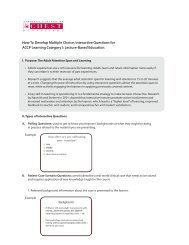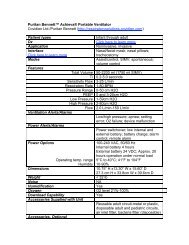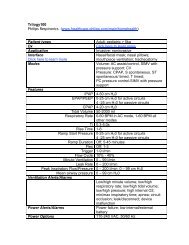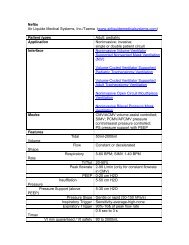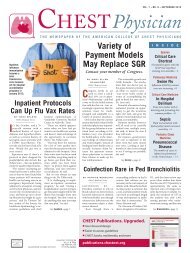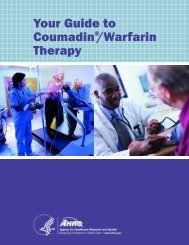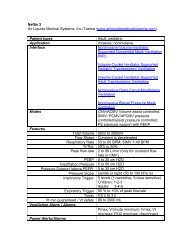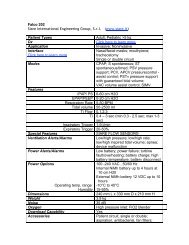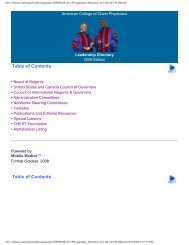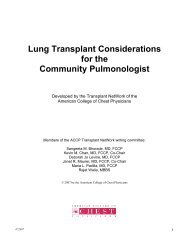Download PDF - American College of Chest Physicians
Download PDF - American College of Chest Physicians
Download PDF - American College of Chest Physicians
Create successful ePaper yourself
Turn your PDF publications into a flip-book with our unique Google optimized e-Paper software.
16 NEWS FROM THE COLLEGE JANUARY 2011 • CHEST PHYSICIANCritical CareThe Kansas Sepsis ProjectSevere sepsis is a common cause <strong>of</strong>mortality, representing the most commoncause <strong>of</strong> death in noncoronaryICUs (Bone et al. <strong>Chest</strong>. 1992;101[6]:1644). Sepsis is rapidly increasing inincidence, projected to affect over1,000,000 patients per year in theUnited States by 2020 (Angus et al. CritCare Med. 2001;29[7]:1303-1310). Ruralpatients develop severe sepsis in similarproportion to urban patients, yet accessto critical care services in rural areas islimited.Telemedicine can help to bridge thegap between the mostly urban supply <strong>of</strong>intensivists and underserved rural patientsand their local physicians (Marcinet al. J Pediatr. 2004;144[3]:375). Varioustechniques have been utilized to addressthis need, ranging from video consultationto teleICU, with reasonable evidencethat such care is comparable tohands-on ICU care (Hersh et al. BMCMedical Informatics and Decision Making.2001;1:5). To further explore uses <strong>of</strong>telemedicine in the specialty <strong>of</strong> criticalcare medicine, a CME/performanceimprovement project dealing with improvingcare <strong>of</strong> patients with sepsis inrural Kansas was implemented via theEli Lilly Distinguished Scholar Award <strong>of</strong>The CHEST Foundation. An objective<strong>of</strong> the project is to empower rural physiciansto appropriately care for their ownpatients with sepsis, as an alternative toreal-time telemedicine consultation.The Kansas Sepsis Project bringsCME and performance improvementto rural Kansas areas via telemedicinein both educational and advisory roles.The project provides a novel methodfor rural medical practitioners to obtainCME credit while performingsepsis quality improvement projectsthat are eligible for maintenance <strong>of</strong>board certification. The overall goal <strong>of</strong>the project is to demonstrate astatewide reduction in sepsis mortalitythrough widespread provider participation,paving the way for similar projectsin other rural states.Dr Lucas R. Pitts; andDr Steven Q. Simpson, FCCP,NetWork Vice-Chair and Third Eli Lillyand Company Distinguished Scholar inCritical Care MedicineCardiovascular Medicine and SurgeryRisk <strong>of</strong> Acute Kidney Injury With SameAdmission Cardiac Catheterization andCardiac SurgeryAcute kidney injury (AKI) after opencardiac operations is associated with increasedmorbidity and short-term andlong-term mortality. Prevention <strong>of</strong> AKIduring and after surgery is <strong>of</strong> paramountimportance. The Acute KidneyInjury Network definition <strong>of</strong> AKI is a0.3 mg/dL or 50% increase in baselinecreatinine value. It is common practiceto provide diagnostic cardiac catheterizationand cardiac surgery in the sameadmission. This practice may lead to ahigher risk <strong>of</strong> AKI with attendant increasedrisks for a higher morbidity andmortality. The question, therefore,remains as to the optimal timing <strong>of</strong> cardiacsurgery following cardiac catheterization.A recent prospective study fromthe Northern New England CardiovascularDisease Study Group looked atthe incidence <strong>of</strong> AKI after cardiaccatheterization in 668 patientsundergoing nonemergentcardiac surgeryduring the same hospitaladmission (367 patients)or a later admission (301patients) (Kramer et al.Ann Thorac Surg. 2010;90[5]:1418).The incidence <strong>of</strong> AKIwas 50.2% in the sameadmission group vs33.7% for the later admissiongroup. The differencewas highly significant (P=.009).Patients undergoing surgery at a lateradmission had a 45% reduction in AKI.The authors concluded that “it is safeand possibly beneficial in terms <strong>of</strong>renal protection, to send patients homeafter cardiac catheterization with aplan for surgery during subsequent admission.”Dr G. Hossein Almassi, FCCPNetWork Vice-ChairAllied HealthSleep Disorders Specialty Exam AccreditedThe National Board for RespiratoryCare (NBRC) invested several yearsdeveloping an examination for respiratorytherapists specializing in sleep disordersand therapeutic intervention.Candidates must be credentialed respiratorytherapists with clinical experiencein the testing, monitoring,diagnosis, and treatment <strong>of</strong> patientswith sleep disorders. Successful candidatesreceive either the CRT-SDS orRRT-SDS federally trademarked credentialdesignation depending onwhether they attempted the examinationas a CRT or an RRT.The specialty examination was developedin accordance with stringent psychometricand other standards putforth by the National Commission forCertifying Agencies. This body also accreditsthe registered polysomnographictechnologist (RPSGT)examination <strong>of</strong>fered by the Board <strong>of</strong>Registered Polysomnographic Technologists(BRPT). Both the RPSGT andsleep disorders specialty (SDS) examinationswere developed based on jobcontent identified by national jobanalysis research.Test specifications for the NBRC’sSDS examination can be reviewed andprinted by accessing the NBRC Website at nbrc.org and clicking on the“Examinations” tab. An online, fulllength,free practice examination isalso available.The new specialty examination wasdeveloped in response to requests fromNETWORKSSepsis, Acute Kidney Injury, Sleep Disorders, Fluthe NBRC’s sponsors. The Board <strong>of</strong>Trustees is pleased to announce thenew examination was recently accreditedby the National Commission for CertifyingAgencies (NCCA), continuing along tradition <strong>of</strong> NCCA accreditationfor all <strong>of</strong> the NBRC’s credentialing programs.The NBRC was one <strong>of</strong> the firstfour organizations to have its examinationsaccredited in 1977when the NCCA wasformed, and it is the onlyorganization to continuouslymaintain accreditation<strong>of</strong> its credentialingprograms for more than30 years.Gary A. Smith, CRT,FAARCNetWork SteeringCommittee Member<strong>Chest</strong> InfectionsInfluenza: Brief Comments on the Recent2009 Influenza A(H1N1) Epidemic andObservations on VaccineSporadic outbreaks <strong>of</strong> highly virulentavian H5N1 influenza and the recentoutbreak <strong>of</strong> a pandemic A(H1N1) virushave heightened concerns about theeventual emergence <strong>of</strong> a particularlydeadly pandemic virus. Influenza Avirus represents one <strong>of</strong> the most prominentviral pathogens <strong>of</strong> modern times.Infection with this microbe results in anestimated 36,000 deaths 1 and over200,000 hospitalizations 2 in the UnitedStates annually, with a projected totaleconomic burden in excess <strong>of</strong> 80 billionUS dollars per year. 3 According to theCenters for Disease Control and Prevention,the incidence <strong>of</strong> influenzavirus infection in the US populationmay reach 20% during a typical flu season;however, this figure can increasesubstantially during periods <strong>of</strong> pandemicinfluenza. Although influenza istypically a self-limiting disease, seriouscomplications can occur, including primaryviral pneumonia, secondary bacterialpneumonia, myositis, andneurologic syndromes. The risk <strong>of</strong>mortality and disease complications iselevated for certain populations, includingthe young, old, immunosuppressed,and immunocompromised.During the most recent pandemic,infection/disease was witnessed inunique populations, such as pregnantwomen and children, with substantialmortality observed. Elderly individualswere not as predisposed, reflecting previousserologic evidence <strong>of</strong> prior exposureto similar influenza virus strains.The epidemic demonstrated differencesin treatment efficacy for drugs; potentialutilities <strong>of</strong> intensive support, includingalternate ventilatory modes such as extracorporealmembrane oxygenation;and difficulties in administering and allocatingresources. Interactions amongphysicians, health-care delivery systems,and administrations were stressed. Theability <strong>of</strong> influenza A virus to infectmillions <strong>of</strong> people each year speaks tothe resilient nature <strong>of</strong> this pathogenand to the necessity for developing improvedmethods <strong>of</strong> disease preventionand treatment.Although commercial influenza vaccineshave been available since the mid-1900s, a number <strong>of</strong> key challengescontinue to limit the efficacy <strong>of</strong> thesevaccines. The rapid mutation rate <strong>of</strong>immunodominant glycoproteins on thevirus surface necessitates annual revision<strong>of</strong> the vaccine and requires abroad network <strong>of</strong> laboratories to cooperativelyperform surveillance on circulatinginfluenza virus strainsthroughout the year. Importantly, currentstrain-specific vaccines are only30% to 50% effective in preventing hospitalizationand pneumonia in the elderlyand are about 70% effective inpreventing illness in healthy adults.Most recently (late 2010), severalgroups have observed disturbing trends<strong>of</strong> mistrust <strong>of</strong> vaccine formulations(individual components), which haveresulted in refusal <strong>of</strong> vaccination byhealth-care persons <strong>of</strong> all types, includingphysicians and nurses.Despite the extensive variability instrains <strong>of</strong> seasonal influenza, some researchinvestigations have indicated thepotential for developing universallyprotective immune responses againstinfluenza viruses. Over the pastdecade, an array <strong>of</strong> conserved influenzavirus epitopes have been identified,and the ability <strong>of</strong> both cell-mediatedimmune components and humoral immunecomponents to elicit crossprotectiveimmunity to heterologousinfluenza A viruses have been documented.Moreover, the improvement<strong>of</strong> influenza vaccine immunogenicityvia inclusion <strong>of</strong> molecular adjuvantsand modification <strong>of</strong> vaccine modalityhas been widely reported but rarelywithin the context <strong>of</strong> a universal influenzavaccine. Development <strong>of</strong> amaximally efficacious vaccine in primatesmay require alternative approaches,such as a combinatorialformulation containing both immunomodulatorycomponents andconserved influenza antigens.Further research is necessary to refineapproaches to management <strong>of</strong> influenza,both in prevention andtreatment.1. Molinari NA, Ortega-Sanchez IR,Messonnier ML, et al. The annual impact<strong>of</strong> seasonal influenza in the US:measuring disease burden and costs.Vaccine. 2007;25(27):5086-5096.2. Thompson W, Weintraub E,Dhankhar P, et al. Estimates <strong>of</strong> US influenza-associateddeaths made usingfour different methods. Influenza OtherRespi Viruses. 2009;3(1):37-49.3. Thompson WW, Shay DK, WeintraubE, et al. Influenza-associated hospitalizationsin the United States.JAMA. 2004;292(11):1333-1340.Dr Joel F. Aldrich; andDr Richard E. Winn, FCCP,NetWork Steering Committee MemberPages 16a—16b





